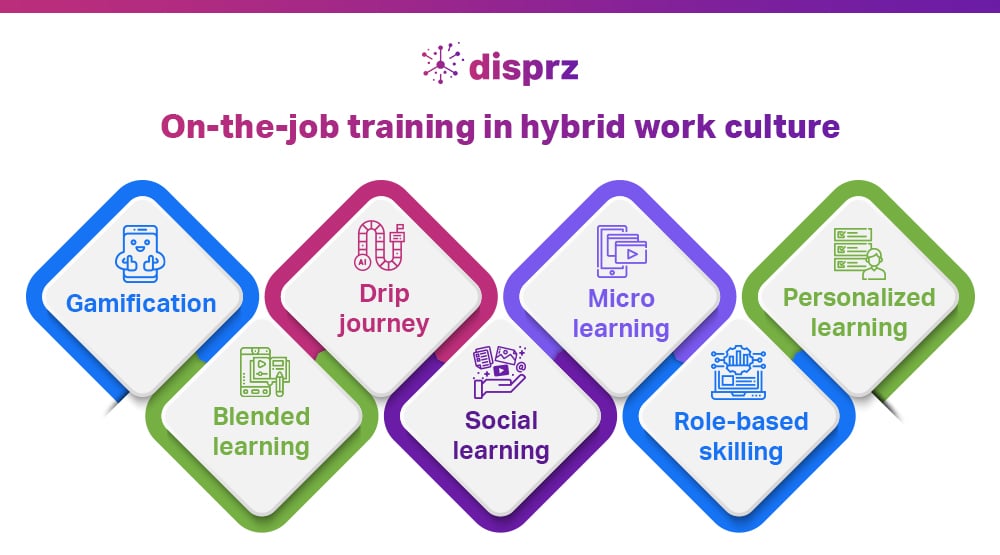Recent research indicates that Americans are not only embracing flexible work locations, but they are expressing a desire for even more flexibility. However, it is not practical for many companies to adopt a fully remote workforce. To accommodate their employees needs and business needs, many companies, like Uber and Spotify, have hopped on the hybrid working bandwagon to give their employees flexibility.
The hybrid work environment presents increased flexibility, enabling your employees to divide their time between working at the office and from remote locations. Achieving the right balance between these two models can foster a content and productive workforce. To ensure your workforce maintains productivity continuous skill development is essential. Providing hybrid workplace training will prepare your workforce to adapt to the ever-changing business landscape with confidence and readiness for the future.

Challenges of managing a hybrid work culture
A hybrid workforce necessitates specialized training and treatment because solid teams might be divided into physical and remote arrangements. Therefore, it may be difficult to deliver relevant and consistent training to both groups. The training challenges in a mixed workplace culture are:
-
Employees must have equal access to relevant, meaningful training that benefits them regardless of their geographical location.
-
New tools and technology, like chat applications, LMS platforms, email, and task management software, enable remote work. However, in order to make the greatest use of these tools, employees must first improve their skills.
-
In a hybrid work setting, core competencies shift. Manual occupations are being mechanized, and employees must be equipped with both communication and technical abilities going forward.
-
A hybrid work environment includes a flexible workplace as an added benefit for employees. To accommodate the hybrid workplace, you must have a flexible business culture and a training program to match it.
7 Strategies to improve hybrid workplace training for your employees

Below are a 7 on-the-job strategies you can implement to provide enhanced hybrid workplace training for your employees.
1) Gamification – Get more interactive
In most virtual learning sessions, the employees are either yawning or scrolling through their Instagram feed with their cameras turned off. A strong stimulus is essential to rekindle the vital spark of attentive learning. Gamification is a great technique to make hybrid workplace training successful.
Whether it is compliance training or a live session on new products or technology updates, Gamification has the power to attract and hold the interest of a hybrid workforce. For instance, Disprz, a complete skilling suite’s Gameinar, enables L&D to make the learning sessions interactive and engaging with its wide gamut of features like a roulette wheel, breakout room, text wall, and sticky notes. Whether the employees are working from home or office, they can connect on the gameinar platform; it is an effective way to bring the distributed workforce on a single platform. Besides, the L&D can take real-time feedback to improve on-the-job training through quizzes and polls.
Moreover, its leaderboards feature strikes healthy competition in a hybrid work environment and motivates employees to enroll and complete maximum courses to achieve more points and badges. Displaying the achievement to others is a great incentive that encourages higher enrolment and completion rates.
2) Blended learning – Combine classroom and online training
Organizations have merged virtual and physical working to offer more convenience through a hybrid work model. Why don’t we apply the same strategy while facilitating corporate learning? Blending classroom and online learning can help balance hybrid workplace training.
For instance, before commencing the classroom sessions, the L&D team can share the necessary resources or outline through a digital learning platform along with the invitation for the session. The employees will have a clear picture of what they will be learning in the classroom sessions. Moreover, post the classroom session, the L&D can send a quiz to understand how much information the employees have aborted from the learning sessions. They can even share documents and presentation decks that employees can refer to in their time of need.
3) Drip journey – Create a learning path by merging various learning formats
Employees get overwhelmed when they are overloaded with information that’s not streamlined. For instance, a sales rep is provided resources on various products, sales scripts, latest policies, updated government norms, new technologies, etc. He is clueless about what to pick first and how to complete everything on his plate, along with managing his routine work.
Employees need a clear direction while working in a hybrid environment, or they will wander in the wilderness like a lost sheep. A drip journey is an effective strategy for offering continuous hybrid workplace training. The L&D head or trainer can create a systematic learning pathway by scheduling specific courses on specific days. For instance, an L&D head can create a four-days learning pathway for a sales representative.
-
First day – Blog on how to manage a sales cycle
-
Second day – Flashcard on new product updates
-
Third day – Webinar on how to manage reluctant buyers
-
Fourth day – Video on various use cases to close a deal
This was just an example; the drip journey can be 15 to 30 days long as per the learning requirement, and more than one task can be added in a day. So employees will have clarity on what they have to learn each day. Regardless of their location, they can easily enroll, complete their daily courses and learn on the job seamlessly. The drip journey can also be used to onboard the new hires. So, a 30-60-90 day onboarding drip journey can be created to get the new employee up-to-speed quickly and amplify time to productivity.
4) Social learning – Create a space for collaborative learning
Either through a tap on the shoulder or while swinging by someone’s desk, knowledge is shared frequently at the workplace. There is always a learning opportunity in such socializing moments, which the employees miss out on while working remotely for half of the week.
Creating a collaborative space where employees can learn from each other is imperative to ensure hybrid workplace training. Social learning opens the door to communication. Through a social wall on a learning platform, employees can share relevant resources, brainstorm new ideas, address various queries, share achievements and contribute to each other’s knowledge growth.
5) Microlearning – Capture attention with knowledge nuggets
Working in a hybrid model has its own set of challenges. One of the most pressing issues is lack of time. However, microlearning gives an opportunity to provide on-demand learning in a busy work environment.
Most learning platforms offer mobile learning solutions that can be leveraged for sharing knowledge nuggets. The bite-sized content has the magnetic potential to attract learners. Moreover, presenting it in a compelling flashcard on mobile can increase the engagement rate. The versatility of microlearning captures interest.
Developing precise content based on use cases can help deliver an immersive learning experience to the hybrid workforce. Microlearning supports the workforce in the hour of need. They can instantly learn and apply what they’ve learned to work. Moreover, microlearning can be used to provide a summary of a long training session or even share a synopsis for the upcoming session.
6) Role-based skilling – Identify and benchmark skills for each role
In a traditional organizational structure, businesses would focus on hiring “skilled” professionals, put them in a role, and assume they would deliver optimum performance using their expertise and experience.
In today’s hybrid work environment, assumptions lead to disastrous outcomes. In the era of fast-changing skills, companies cannot rely on the skills highlighted in a resume to enter an organization. It is important to react quickly and keep an eye on the changing skills.
Each role is different; hence identifying and benchmarking the trending skills for each role is crucial. A powerful skilling solution like Disprz enables L&D to identify and drive the skills they should focus on for boosting performance and reaching organizational goals.
7) Personalized learning – Leverage AI to customize training based on different skill level
Personalization is the key to making training successful in a hybrid work environment. Burnout is one of the emerging issues in hybrid work culture. Employees feel stuck in the same position without any sign of growth. Providing learning that doesn’t align with individual aspiration lead to more anxiety. Hence assessing employee skill gaps and understanding their learning requirement and aspirations is essential to driving a personalized learning experience in hybrid work culture.
AI-powered tools like LXP can help create a personalized journey for hybrid workplace training. Based on the skills and interests of the employees, the AI recommends the latest and most relevant content to the employee to constantly learn and advance in their careers.
Ways to measure the performance of remote or hybrid employees
Measuring the performance of remote or hybrid employees is essential for effective management in today's dynamic work landscape. Employing specific strategies ensures productivity and success in dispersed work environments.
Outcome Evaluation
-
Track goal attainment to assess effectiveness.
-
Utilize productivity tools and project milestones for objective evaluation.
Group Cohesion
-
Ensure seamless team integration for hybrid setups.
-
Foster a collaborative environment to enhance team performance.
Individual Development
-
Support personal growth within the team framework.
-
Emphasize individual development alongside team participation.
Performance Metrics
-
Conduct regular evaluations using customized performance metrics.
-
Establish clear communication channels and feedback mechanisms.
By implementing these strategies, managers can effectively measure and enhance the performance of their remote or hybrid employees, promoting productivity in modern work environments.
Conclusion
Hybrid workplace training creates seamlessness in a hybrid work environment. However, it is crucial to back it up with the right technology. A modern skilling suite can help drive impactful learning experiences in a hybrid workplace.
Disprz LXP skilling suite provides the perfect platform that empowers companies to make available a host of digital content, in-house content, and micro-gigs to make training more holistic in a hybrid working environment. Through periodic assessments and feedback, managers can assess current skill levels and guide the employees on the right path.
Features that surge adoption like leaderboard, social learning, and nuggets that support multi-lingual learning makes Disprz more than just a learning app – a collaboration, engagement, and business-led skilling tool.










